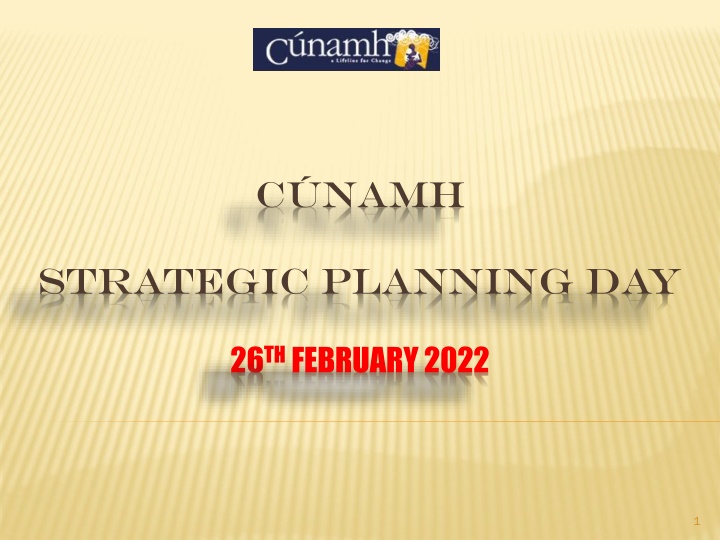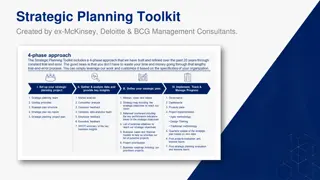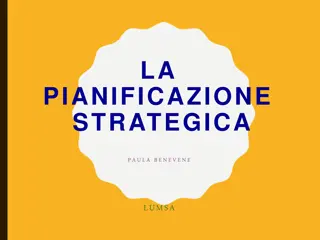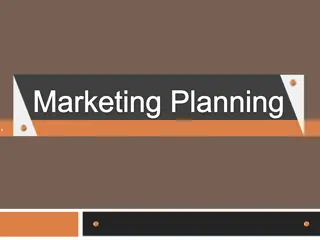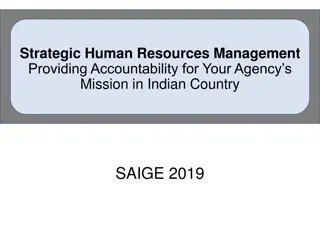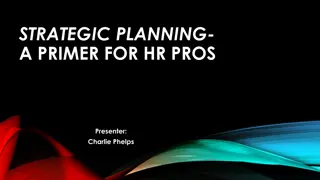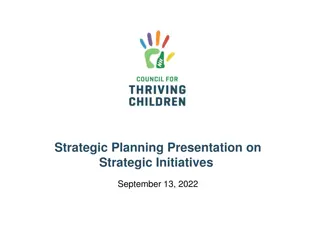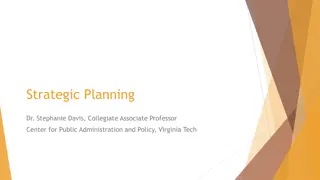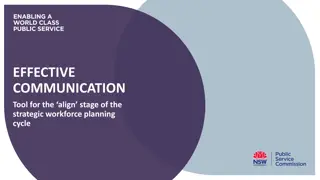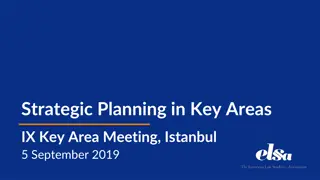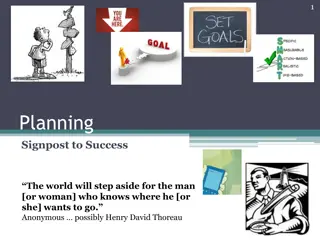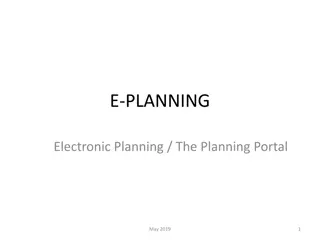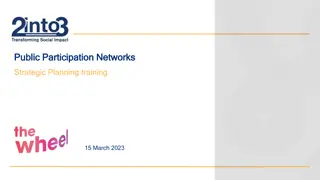C.namh Strategic Planning Day
Individuals provided safe place to explore feelings related to past traumatic experiences. Supportive environment for personal and community development. Community-led support system established with dynamic model for implementation elsewhere. Mission to cater for emotional and psychological impact of conflict, responsive to wider community needs. 3-year strategic plan focused on addressing needs arising from conflict and evolving local community needs, offering range of support services and therapeutic programs.
Download Presentation

Please find below an Image/Link to download the presentation.
The content on the website is provided AS IS for your information and personal use only. It may not be sold, licensed, or shared on other websites without obtaining consent from the author.If you encounter any issues during the download, it is possible that the publisher has removed the file from their server.
You are allowed to download the files provided on this website for personal or commercial use, subject to the condition that they are used lawfully. All files are the property of their respective owners.
The content on the website is provided AS IS for your information and personal use only. It may not be sold, licensed, or shared on other websites without obtaining consent from the author.
E N D
Presentation Transcript
CNAMH STRATEGIC PLANNING DAY 26TH FEBRUARY 2022 1
Aims & Objectives Aims & Objectives To provide individuals with a safe place to explore and understand their feelings in relation to past traumatic experiences as they enter into the healing process To provide individuals with a supportive and friendly environment in which they can actively negotiate various routes for change on their personal development and the development of their communities To establish a durable community-led support system To document the process as a dynamic model of progressive community support for implementation elsewhere. 2
Vision Statement C namh aspires to a community and society whose health, mental health and wellbeing is thriving through access to personal and community development opportunities. Mission Statement To provide a community-led and based service catering for the emotional and psychological impact which conflict has had on individual and community wellbeing, and responsive to the emergent needs of the wider community. 3
3 Year Strategic Plan 2009 2012 Values C namh's work was piloted within the Bogside and Brandywell area of Derry, which is a nationalist/republican community. This community's experience of the conflict has been of acts and events caused mainly by British State forces, including Loyalist forces. C namh firmly believes that the process of recovering from negative emotional and psychological impacts must initially take place within a safe and empathetic environment. C namh also believes that individuals and communities are entitled to support structures which respect and understand their experiences, and which are outside of state-initiated or statutory provision. As well as dealing with the legacy of the conflict, C namh also believes in responding to need as it develops over time. C namh s history and identity is the strong base from which we open out to the evolving / changing society in which we live. 4
Strategic Aim 1 To offer a range of support services addressing needs arising from the conflict and evolving local community need, including counselling, drop-in, information and other support services, geared towards helping people to experience the best possible mental and emotional health and well-being. Objective 1. To provide a range of therapeutic support services aimed at promoting good health and all aspects of well-being. Counselling Cognitive Behavioural Therapy Complementary Therapy Drop-in Advocacy/Caseworker/Welfare Advice Social Support Programmes Eating Disorder Service 5
Objective 2: Evaluation To develop a package of care on an ongoing basis that is evaluated using appropriate measures and standards. Individual - Corenet; MYMOP; WSAP online measurement tools; Feedback from clients. Project/Organisational Funding Body requirements; Board Meetings; Legal requirements, e.g. Charities Commission 6
Strategic Aim 2 - Organisational Development To continually develop C namh positively as a best practice organisation. Objective 1: Communications Regular staff meetings Regular Management Committee/Staff liaison Clinical Staff meetings Clear Policy & Procedure Manual Regular Management committee meetings 7
Objective 2: Staff Development Conduct ongoing TNA with staff. Support staff with Ongoing Professional Development Review volunteer policy considering the rationale, function and development needs of volunteers in the organisation 8
Objective 3: Premises Ensure the pemises are fit for purpose and accessible for all clients. Objective 4: Security & Safety Office is regularly checked for adherence to health & safety requirements Staff are familiar with risk management procedures and these are reviewed and updated regularly GDPR is fully implemented and clients are provided with it. 9
Strategic Aim 3 - Outreach and Relationships To reach people in need beyond the immediate community already involved with C namh. Objective 1: To carry out outreach work in other areas responsive to demand Objective 2: To share the C namh model with other interested communities of practice in an appropriate fashion, where this is in keeping with our aims and values. Objective 3: To investigate cross-border and cross-community relationships and associated resources. 10
Strategic Aim 4 - Profile and Publicity To raise the public profile of C namh, both its role and the needs of its client group, so that they receive greater recognition, validation and support. Objective 1: To target market C namh to the different sectors relevant to the field of mental and emotional care and wellbeing, by producing distinct and discrete publications. - Mental Health Booklet, Website updates, FB. Objective 2: To agree the appropriate level of profile for C namh in the public eye, and with funders and other providers. - Client demand; notification of programmes and services on FB and website. Objective 3: To undertake a public relations campaign aimed at attaining that profile which could include: Working collaboratively with other groups and seek publicity for it Attending events to publicise and network on behalf of C namh Utilising the website more effectively for Public Relations Participating in partnerships and networks beyond the local area 11
Timeline of Significant Events/Developments since 2013 Professional Skills and Accreditation Emergence of formal Service Level Contracts - WHSCT Delivery of new projects Eating Disorder Emergence of Casework Service Security of 3/5 year Core funding cycle 12
Overview of Service/Programme Delivery Talking Therapies Complementary Therapies Social Support Programmes Advocacy/Welfare Advice Caseworker Service 13
Since 2000 the organisation has delivered 12,500 Counselling sessions; 6,200 CBT sessions and 6,000 Complementary Therapy sessions. Since 2014 The Eating Disorder project has provided 738 individual sessions to 62 young people and their families Since 2017 The Caseworker Service has provided 738 clients with support for a range of schemes and aids, including TFPA, Disability Aids, Psychological Therapies, Social Isolation, Education & Training, Persistent Pain & Volunteering 14
Source of Referrals 75% 80% 70% 60% 50% 40% 20% 30% 20% 2% 1% 1% 1 10% 0% Community Organisation GP Not Recorded Self Statutory Organisation VSP Funded Organisation 15
Age Range of Clients 35% 30% 30% 25% 23% 18% 21% 20% 15% 10% 4% 4% 5% 0% <20 20-29 30-39 40-49 50-64 >64 Age Range 16
GENDER SPLIT OF CLIENTS Male 44% Female 56% 17
Age Range of Male & Female Clients 32% 29% 35% 27% 26% 30% 20% 20% 25% 17% 15% 20% 15% 6% 10% 4% 1% 3% 5% 0% <20 20-29 30-39 Male 40-49 50-64 >64 Female 18
Employment Status of Clients 35% 34% 40% 35% 30% 25% 11% 20% 7% 15% 5% 3% 3% 10% 1% 1% 5% 0% 19
Issue Recorded at Assessment 30% 27% 25% 20% 13% 15% 8% 8% 7% 7% 10% 5% 5% 4% 4% 3% 1%1%2%1% 1% 5% 1% 1% 1% 0% 0% 0% 0% 0% 0% 20
BENEFITS OF THERAPY Access to Practical Help Not Addressed 6% No Data 3% Unimproved 1% Improved Unimproved Not Addressed No Data Improved 90% 21
Control/planning/decision making Not Addressed 6% No Data 3% Unimproved 2% Improved Unimproved Not Addressed No Data Improved 89% 22
Subjective Well-being Not Addressed 4% No Data 3% Unimproved 1% Improved Unimproved Not Addressed No Data Improved 92% 23
Not Addressed 2% Symptoms No Data 3% Unimproved 1% Improved Unimproved Not Addressed No Data Improved 94% 24
Day to Day Functioning Not Addressed 4% No Data 3% Unimproved 1% Improved Unimproved Not Addressed No Data Improved 92% 25
Current & Future Developments & Issues to Consider Victims Permanent Disablement Payment Scheme Regional Trauma Network Impact of Covid-19 Ageing Client Population Legacy Issues New, emerging needs Eating Disorders, Neurodiverse population. Relevant Government Strategies Mental Health, Anti-Poverty etc 26
To Date, What has worked/hasnt worked? What Make us Unique/Different? 27
Strengths o Personal Touch o Humanitarian approach to all issues o Ongoing training o Integrated counselling CBT, CBT-E, Trauma Counselling o Group Support (Staff) o Easy Access to/for all clients o Supportive Team (staff) o Multi disciplinary team o Respond to client needs. o Professional expertise o Personal experience o Community 1st /based o Great teamwork o Management that is informed, highly skilled & who support and encourage. o o o Up to date training Range of services Wealth of experience in dealing with trauma Qualified practitioners Up to date technology Open door policy Learning resources Flexibility Knowledge & skills Interpretive counselling support Professional Approach Can do attitude Good Communication Listening ethos Friendly o o o o o o o o o o o o 28
Weaknesses o Self-promoting o Premises o Access to building aging clients, limited abilities o Recording ALL contacts o How we use monitoring info o Not enough young people in the organisation o We don t sing our praises enough o Haven t shared our practical experience to our advantage o Capacity o Identity o Too busy working not enough time to create new approaches o Need to look after and care for each other more o Not enough space o Disability access o Not enough finances o Not good at capturing our successes, verbal feedback from clients o Capturing the positive change in clients o Getting appropriate referrals-VSS, through the doors o Getting people to know about us and what we do o Capturing all available data on clients to inform practice 29
Opportunities o Well informed therapists promote this via lectures, local initiatives, schools, higher education? o PHD Research Student o C namh what s in a name how do we pronounce it? What does it stand for? o More outdoor therapeutical approaches o New premises or other premises o Look back to former clients Re-engage? o More advocacy Advice lines etc o Technology o Digital delivery 30
Threats o If we promote do, we overstretch o Premises o Competing organisations o Withdrawal of funding o Demands of funders o Lack of knowledge of your work o Other organisations doing similar work o Complacency o Succession planning 31
Issues/Factors for Consideration Political Potential of instability within Assembly, and subsequent impact upon funding. Ongoing disagreement over dealing with the past and distress to victims/survivors Environmental Physical space and limitations for reduced mobility and disabled clients, needs to be continuously assessed. Social New migrant community members should be specifically reached out to, by strengthening relationships with outreach forums and interpreter services. Technical Optimal use of social media to be explored to raise awareness of services and engagement with hard to reach and vulnerable groups. 32
